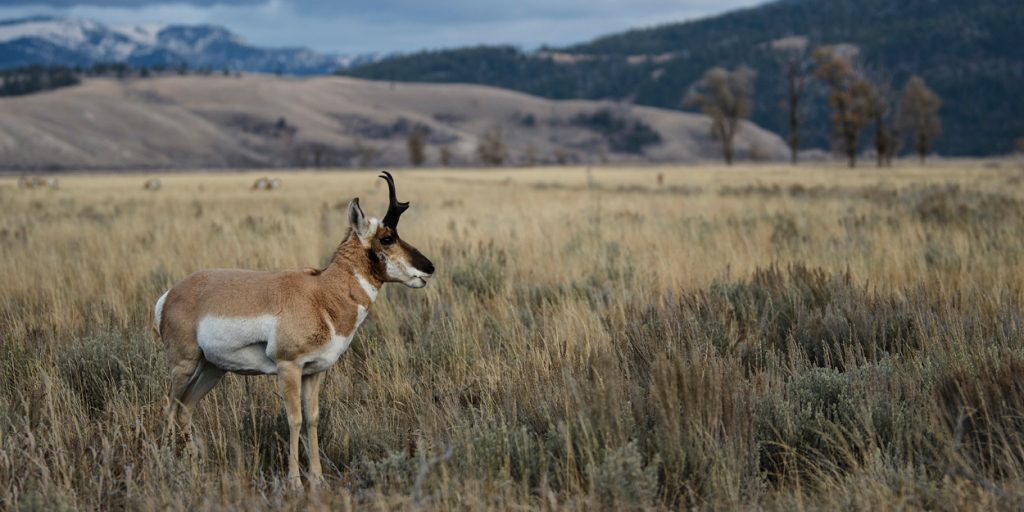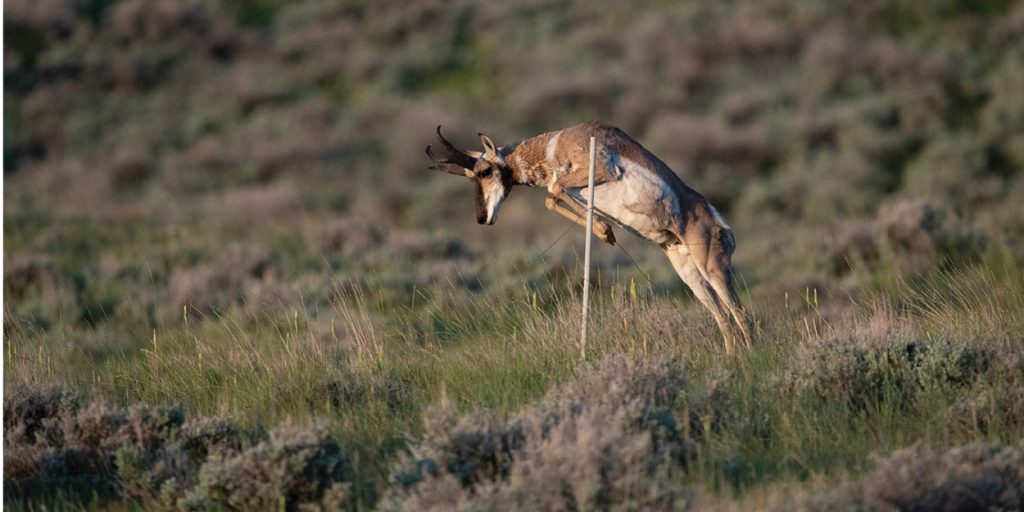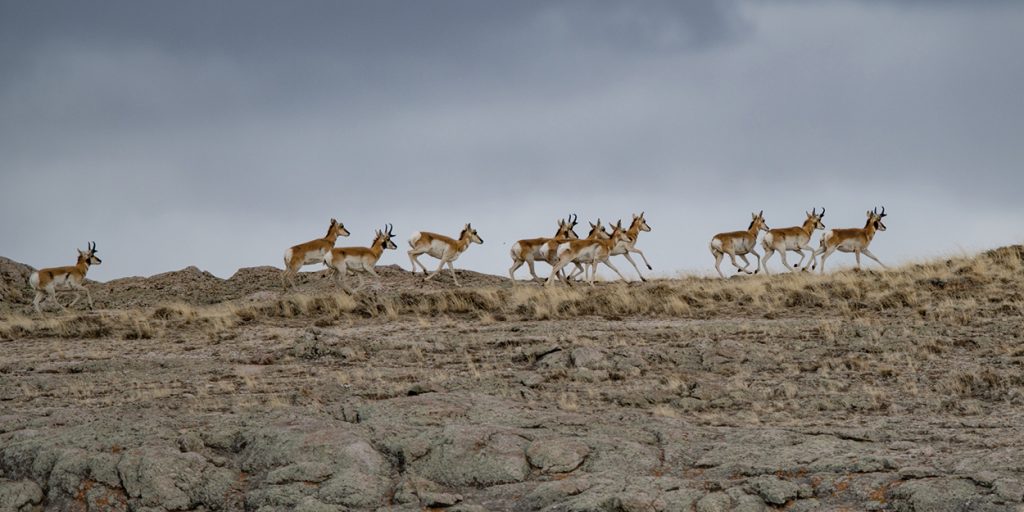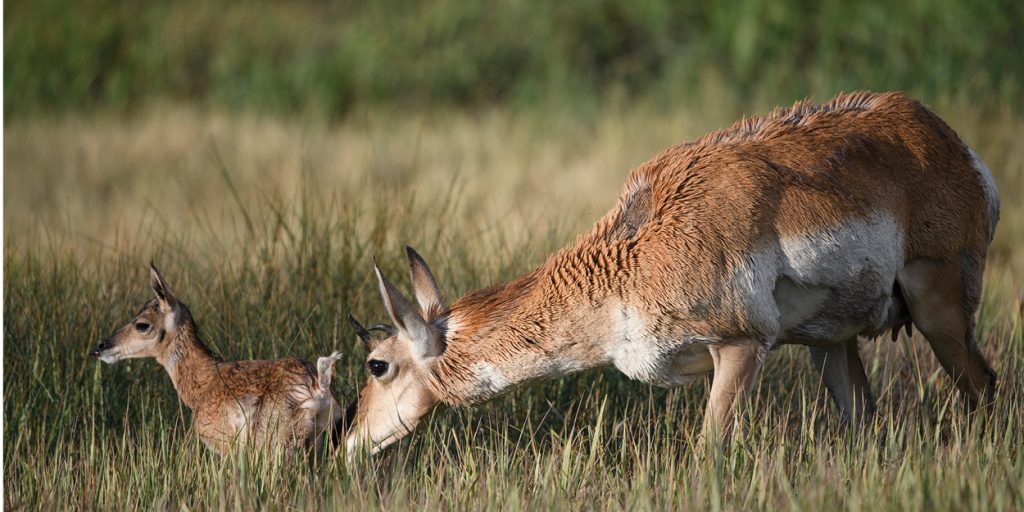
As of May 2, 2025, the comment portal has closed — but you and others raised your voice in a big way! WOC supporters participated in droves, submitting 274 online and at in-person events. If you submitted a comment, thank you. This strong show of public support for conserving the Sublette Pronghorn Migration Corridor will matter at the July Wyoming Game and Fish Commission meeting when commissioners vote on whether to recommend designation to the governor. Stay tuned to hear the outcome of that vote later this summer.
ACT NOW TO PROTECT PRONGHORN MIGRATION
We’re on a mission to protect the Sublette Pronghorn herd migration corridor —
and we can’t do it without your help.
According to an exhaustive Biological Risk and Opportunity Assessment from the Wyoming Game and Fish Department, the Sublette Pronghorn herd’s migration corridor is at risk. From residential subdivisions, to energy development, to road and fence impacts, migrating pronghorn face ever-increasing barriers on their journey. Thankfully, the agency is midway through the process of formally designating the corridor, which would help address obstacles and better protect pronghorn.
It’s up to us to show overwhelming support to help push this process forward! Read on to learn how to comment, why this migration needs protection, and the ins and outs of the designation process. Although the formal public comment period has closed, you can always send a note to members of the Wyoming Game and Fish Commissioner and Governor Gordon expressing your support for designating the Sublette Pronghorn Migration Corridor.
ADD YOUR VOICE FOR MIGRATION PROTECTIONS
If we want to see corridor designation move forward for Sublette Pronghorn, this is our chance to show overwhelming public support for the process and WGFD’s Biological Risk and Opportunity Assessment. Although the designation process is far from over, this is the last meaningful opportunity to provide public comment and sway decision-makers — don’t miss your opportunity to weigh in!
We know for a fact that public comments make a difference in this process. Last year, when the Wyoming Game and Fish Commission started down the path towards designation, supportive public input played a key role. Biologists touted that the hundreds of public comments received were over 90% supportive of designation as they made their case to the Commission – a compelling argument in favor of migration corridor protections!
If we want to counteract voices that are skeptical of designation, it will take another strong showing during this final public comment period.
WE REACHED (AND SURPASSED) OUR GOAL! THANK YOU!
We were aiming for 200 comments in support of migration corridor protections. We got 274!
Your comments will put us closer to the finish line — and closer to lasting protections for Sublette Pronghorn!
Why designate the Sublette Pronghorn Migration Corridor
- Existing protections are insufficient to maintain connectivity. The Biological Risk and Opportunity Assessment makes clear that this migration corridor is not secure. From subdivisions, to energy development, to fence and road impacts, the forces that make it harder for Sublette Pronghorn to migrate are pervasive and growing. To ensure the functionality of this migration corridor, official designation is essential.
- This herd needs our help. Nearly half of the Sublette Pronghorn herd died in the winter of 2022–23 due to harsh conditions and a disease outbreak, dropping from an estimated 43,000 pronghorn to 24,000. Northern segments of the population were hit particularly hard, with recovery slow and precarious. Meanwhile, animals that were able to migrate further south towards I-80 had much better survival rates, illustrating the importance of keeping migratory pathways open.
- Unobstructed bottlenecks are crucial. Bottlenecks account for only about 1 percent of the migration corridor footprint, but have an outsized impact on the ability of pronghorn to move across the landscape. Because movement is constricted in bottlenecks, there is a higher potential to sever a migration in these spots. Let’s do all we can to maintain movement in these 12 tiny, pivotally important choke points.
- Designation will improve siting of new development. Designating the Sublette Pronghorn migration corridor opens the door for WGFD to work with industry early in the project planning process to minimize impacts in this seasonally vital habitat. This will be increasingly important as newer industries come to Wyoming that need help from state wildlife managers to determine best practices for responsible development.
- The data is comprehensive. With 20 years of data from over 400 collared pronghorn, the science used to map this corridor is incredibly thorough and provides reliable direction to protect sensitive habitat.
- Designation will protect a natural wonder of Wyoming. The Sublette herd is among the largest pronghorn populations on Earth and undertakes one of the longest remaining terrestrial migrations in existence. The herd’s migration corridor

AN ASTOUNDING AND DIFFICULT JOURNEY
Each year, Sublette Pronghorn make an incredible migration from their summer habitat as far north as Grand Teton National Park to their winter ranges in the Green River Basin — a journey that includes the world-renowned ‘Path of the Pronghorn.’ These animals rely on migration to find food, give birth to their young, and escape harsh winter conditions. It’s a grueling journey filled with obstacles. Some pronghorn travel as far as 165 miles, encountering dangerous highway crossings, fences that impede passage, and human development, among other challenges.
Formal designation of the Sublette Pronghorn migration corridor would ease the journey for these resilient travelers. Read on to find out how!
HUMAN DEVELOPMENT IMPACTS. Habitat fragmentation is the top threat to migrating pronghorn in the Sublette herd. In addition to direct habitat loss from residential and industrial development, Migrating pronghorn can abandon adjacent habitat and travel more quickly through these areas. They spend precious energy avoiding development and searching for less disturbed habitat. Formal designation of the corridor would guide industrial development away from the most heavily trafficked, and sensitive portions of the migration corridor while empowering landowners and local governments to make informed decisions about new residential development.
IMPERMEABLE FENCES STOPPING PRONGHORN IN THEIR TRACKS. Although pronghorn have the ability to jump, they most often duck under fences — if the bottom wire is high enough. If it’s not, pronghorn will travel many miles along fencelines, expending precious energy while they scout for a way through. Designating the Sublette Pronghorn migration corridor would prioritize funding for fence conversion and modification projects in areas where pronghorn travel, helping them conserve energy and complete their journey more easily.
INFESTATIONS OF INVASIVE WEEDS. Pronghorn depend on healthy sagebrush habitat, but invasive weeds such as cheatgrass often outcompete native plants, leading to hotter, bigger, more frequent wildfires that degrade habitat further. When traveling through rangelands with infestations of invasive species, pronghorn may struggle to find the varied and nutritious forage required to sustain their migration. Designating this corridor would prioritize funding for habitat restoration and weed control on properties that overlap the herd’s migratory pathway.
RISKY ROAD CROSSINGS. In Wyoming, an average of 593 vehicle collisions with pronghorn occur each year. Wyoming has done a lot of work to improve highway safety for people and wildlife in the past fifteen years, but designating the corridor could help open up funding streams and prioritize roadway management that takes the needs of pronghorn into account, including reduced speed limits and appropriate signage in zones of heavy pronghorn traffic. A win for migrating pronghorn—and for motorists!

A ROADMAP TO DESIGNATION
The path to migration corridor designation unfolds over three main phases.
Phase 1 centers on a “threat evaluation.” A map for the migration corridor is drafted and WGFD biologists identify existing threats to the migration as well as protections already in place. If biologists judge the existing protections to be insufficient, the agency will recommend moving forward with the designation process.
The public then has a chance to weigh in on the draft map and threat evaluation before biologists bring their recommendation before the Wyoming Game and Fish Commission.
Based in part on massive outpouring of public support for moving forward with the designation process during the public comment process, the Commission voted to move forward with the designation process in March of 2024.
ACHIEVED MARCH 2024
*WE ARE HERE* Phase 2 centers on a “biological risk and opportunity assessment.” This requires a more thorough analysis of each segment of the corridor by WGFD and is meant to be completed in twelve months. When a draft is complete, biologists will once again seek public input before finalizing the risk assessment and bringing it before the Game and Fish Commission. If the Commission chooses to recommend migration corridor designation to the Governor, we enter the final phase of the designation process. This is where we are in the process right now!
WE ARE HERE!
Phase 3 of the designation process largely depends on the Governor. If they opt to proceed, they will appoint an “Area Working Group” tasked with forming recommendations for corridor designation. This group will include affected county commissions and Tribes as well as representation from conservation, hunting, motorized recreation, agriculture, and industry groups.
Area Working Groups will meet in public and consider the biology, conservation opportunities, and socioeconomic implications of corridor designation before presenting their recommendations to the Governor. Finally, the Governor will formally designate the corridor, return the recommendation to WGFD for further refinement, or reject the designation.
DEPENDENT ON OUTCOME OF PHASE 2

LOOKING FOR MORE WAYS TO HELP?
Submitting your comment in support of corridor designation makes an impact — thank you! If you’re looking for more ways to help, consider making a gift in support of our vital conservation efforts. Our team of conservation professionals is working to support migration corridor designation at every step of the process, and your gift makes a difference.
